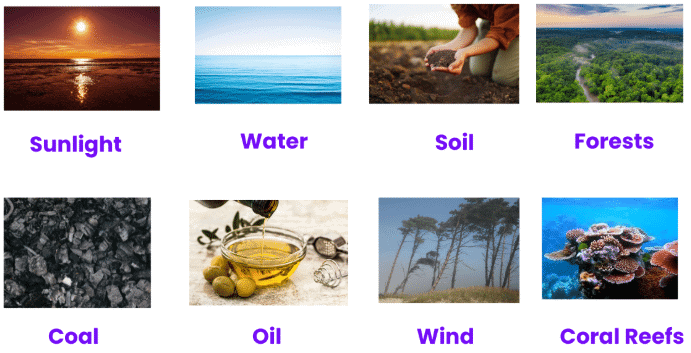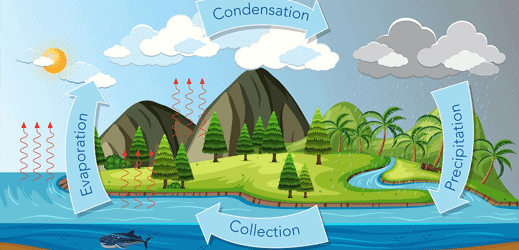Short & Long Question Answers: Nature’s Treasures | Short & Long Answer Questions for Class 6 PDF Download
Short Answer Questions:
Q1. What are some natural resources that we depend on every day?
Ans: Some natural resources we depend on daily include water, air, sunlight, soil, plants, and animals. These resources provide us with food, oxygen, shelter, and energy.
Q2. How does oxygen play a role in sustaining life?
Ans: Oxygen is essential for respiration, a process in which our bodies break down food to release energy. Without oxygen, living organisms, including humans, cannot survive.
Q3. What is the importance of sunlight for life on Earth?
Ans: Sunlight provides energy necessary for plant growth through photosynthesis. It also helps regulate the Earth’s climate, provides warmth, and is essential for the survival of most life forms on the planet.
Q4. What makes wind an important natural resource?
Ans: Wind is an important natural resource because it helps in generating renewable energy through wind turbines. It also plays a key role in pollination and in regulating the climate by redistributing heat around the Earth.
Q5. How does water contribute to sustaining life on Earth?
Ans: Water is essential for all life forms, as it is used for hydration, agriculture, and sanitation. It also plays a crucial role in regulating temperature and supporting ecosystems.
Q6. What is rainwater harvesting, and why is it important?
Ans: Rainwater harvesting is the collection and storage of rainwater for future use. It is important because it helps conserve water, reduces dependence on groundwater, and provides an alternative water source in areas with water shortages.
Q7. What are fossil fuels, and why are they considered non-renewable?
Ans: Fossil fuels like coal, oil, and natural gas are energy sources formed from the remains of ancient plants and animals. They are non-renewable because they take millions of years to form and are being used faster than they can be replenished.
Q8. How does solar energy benefit the environment?
Ans: Solar energy is a clean, renewable energy source that does not pollute the environment. It helps reduce reliance on fossil fuels, decreases greenhouse gas emissions, and can be used to generate electricity and heat for homes and industries.
Q9. Why should we conserve natural resources?
Ans: We should conserve natural resources to ensure their availability for future generations, protect ecosystems, and reduce the negative environmental impact caused by overuse or waste. Natural Resources
Natural Resources
Q10. What role do forests play in maintaining the balance of nature?
Ans: Forests provide habitat for wildlife, help in carbon dioxide absorption, produce oxygen, prevent soil erosion, and regulate the water cycle. They are crucial for biodiversity and maintaining ecological balance.
Long Answer Questions:
Q1. Discuss the importance of conserving natural resources and the impact of their overuse.
Ans: Conserving natural resources is essential for ensuring their availability for future generations. Overuse of resources like water, fossil fuels, and forests leads to depletion, environmental degradation, and loss of biodiversity. For example, deforestation can cause soil erosion, while overuse of fossil fuels contributes to climate change. By conserving resources, we can maintain ecological balance, reduce pollution, and promote sustainability, ensuring that future generations can meet their needs without compromising the environment.
Q2. Explain how the Sun provides energy for life on Earth, including its role in the water cycle.
Ans: The Sun is the primary source of energy for life on Earth. It powers photosynthesis, which allows plants to produce food, supporting the entire food chain. The Sun’s energy also drives the water cycle by causing evaporation, which turns water from oceans, rivers, and lakes into vapor that rises into the atmosphere. This vapor condenses into clouds, and eventually, precipitation (rain, snow) falls back to the Earth, replenishing water sources. The Sun’s energy is crucial for maintaining the climate and supporting all forms of life.
Q3. How does wind energy work, and why is it considered a sustainable resource?
Ans: Wind energy works by converting the kinetic energy of the wind into electrical energy using wind turbines. When the wind blows, it turns the blades of a turbine, generating electricity. Wind energy is considered sustainable because it is a renewable resource; wind will continue to blow as long as the Earth rotates, and the process does not release harmful pollutants or greenhouse gases into the atmosphere, making it environmentally friendly.
Q4. Describe the process and benefits of rainwater harvesting.
Ans: Rainwater harvesting involves collecting rainwater from rooftops, stored in tanks or underground reservoirs for later use. This process reduces reliance on municipal water supplies and helps conserve groundwater. The benefits include providing an alternative water source for drinking, irrigation, and other household needs. It also reduces the risk of flooding and soil erosion by capturing rainwater before it runs off, helping maintain the local water table.
Q5. What is the role of trees and forests in maintaining a balanced ecosystem?
Ans: Trees and forests play a crucial role in maintaining a balanced ecosystem by providing oxygen, reducing carbon dioxide levels, and maintaining the water cycle. Forests act as natural habitats for wildlife, contribute to the purification of air and water, and regulate temperature. They prevent soil erosion by stabilizing the soil with their roots and help mitigate climate change by absorbing carbon dioxide. The loss of forests can lead to the destruction of habitats, reduction in biodiversity, and contribute to climate change, making forest conservation vital for ecosystem health.
FAQs on Short & Long Question Answers: Nature’s Treasures - Short & Long Answer Questions for Class 6
| 1. What are some examples of nature's treasures found in the environment? |  |
| 2. How do natural resources contribute to human life? |  |
| 3. What is the importance of conserving nature's treasures? |  |
| 4. How can individuals contribute to the preservation of nature's treasures? |  |
| 5. What role do government policies play in protecting nature's treasures? |  |





















